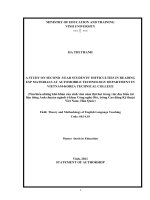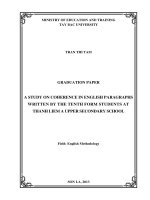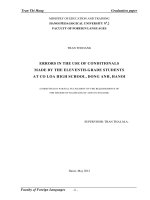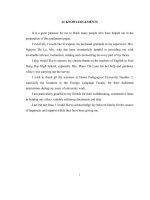A Study on Pronunciation Mistakes Commonly Committed by the 8th Grade Students at Le Quy Don Secondary School, Hanoi Related to English Fricative and Affricativ
Bạn đang xem bản rút gọn của tài liệu. Xem và tải ngay bản đầy đủ của tài liệu tại đây (2.75 MB, 59 trang )
VIETNAM NATIONAL UNIVERSITY, HA NOI
UNIVERSITY OF LANGUAGES & INTERNATIONAL STUDIES
FACULTY OF POST- GRADUATE STUDIES
---- ----
TRẦN THỊ THU HỒNG
A STUDY ON PRONUNCIATION MISTAKES COMMONLY COMMITTED BY
THE 8TH GRADE STUDENTS AT LE QUY DON SECONDARY SCHOOL,
HANOI RELATED TO ENGLISH FRICATIVE AND AFFRICATIVE SOUNDS
AND SOME POSSIBLE PEDAGOGICAL SOLUTIONS
Nghiên cứu lỗi phát âm thường gặp liên quan tới âm xát và tắc xát
trong Tiếng Anh của học sinh lớp 8 trường trung học cơ sở Lê Quý
Đôn, Hà Nội và một số giải pháp trong thực tiễn giảng dạy.
M.A MINOR PROGRAMME THESIS
Field : English Language Teaching Methodology
Code : 60.14.0111
Hanoi, 2013
VIETNAM NATIONAL UNIVERSITY, HA NOI
UNIVERSITY OF LANGUAGES & INTERNATIONAL STUDIES
FACULTY OF POST- GRADUATE STUDIES
---- ----
TRẦN THỊ THU HỒNG
A STUDY ON PRONUNCIATION MISTAKES COMMONLY COMMITTED BY
THE 8TH GRADE STUDENTS AT LE QUY DON SECONDARY SCHOOL,
HANOI RELATED TO ENGLISH FRICATIVE AND AFFRICATIVE SOUNDS
AND SOME POSSIBLE PEDAGOGICAL SOLUTIONS
Nghiên cứu lỗi phát âm thường gặp liên quan tới âm xát và tắc xát
trong Tiếng Anh của học sinh lớp 8 trường trung học cơ sở Lê Quý
Đôn, Hà Nội và một số giải pháp trong thực tiễn giảng dạy.
M.A MINOR PROGRAMME THESIS
Field : English Language Teaching Methodology
Code : 60.14.0111
Supervisor : Assoc. Prof. Dr Võ Đại Quang
Hanoi, 2013
CERTIFICATE OF ORIGINALLY
I, the undersigned, hereby certify my authority of the study project report entitled
“ A Study on Pronunciation Mistakes Commonly Committed by the 8th Grade
Students at Le Quy Don Secondary School, Hanoi Related to English Fricative and
Affricative Sounds and Some Possible Pedagogical Solutions.”
Submitted in partially fulfillment of the requirements for the degree of MA in
English Teaching Methodology.
Except where the reference is indicated, no other person‟s work has been used
without due acknowledgement in the text of the thesis.
Hanoi, 2013
Tran Thi Thu Hong
i
ACKNOWLEDGEMENTS
This thesis could not have been completed without the help and support from a
number of people.
First and foremost, I would like to express my sincere gratitude to Assoc. Prof. Dr.
Vo Dai Quang, my supervisor, who has patiently and constantly supported me
through the stages of the study, and whose stimulating ideas, expertise, and
suggestions have inspired me greatly through my growth as an academic researcher.
A special word of thanks goes to my best friends, students studying at Le Quy Don
Secondary School, and many others, without whose support and encouragement it
would be never have been possible for me to have this thesis accomplished.
Last but not least, I am greatly indebted to my family for the sacrifice they have
devoted to the fulfillment of this academic work.
ii
ABSTRACT
It is clear that learners with good English pronunciation are likely to be
understood even if they make errors in other areas, whereas learners with bad
pronunciation will not be understood, even if their grammar is perfect. Such
learners may avoid speaking in English, and experience social isolation, etc.
Therefore, learners with poor pronunciation may be judged as incompetent, or
lacking in knowledge. Be aware of the importance of English as an international
language as well as the necessary of developing the learner‟s communicative
competence, teaching pronunciation has been constantly noticed.
This minor thesis aims at identifying the most common mistakes when
producing English affricative and fricative sounds by the students grade 8 at Le Quy
Don secondary school, as well as investigating the main causes of these mistakes
and the possible pedagogical solutions to assist them correct their mistakes.
In the course of fulfilling this study, the researcher combined the data from
two main courses: questionnaire for the students to investigate the causes of the
mistakes and recording the informant‟s pronunciation of selected words and words
within utterances and sentences to find out the most common mistakes with English
fricative and affricative sounds.
The data analysis reveals the following major findings: The students have a
tendency to omission and deviation of affricative and fricative sounds both in
syllable-middle and final positions. Their own phonemic habits were carried into
English and the students appear to fail to imitate a proper pronunciation. These
results are taken into account and lead to some pedagogical suggestions to deal with
these problems found.
iii
LISTS OF TABLES
Table 1: Vietnamese initial and final consonants Table 2
Table 2: Sounds mispronounced by Vietnamese students (Tam,2007)
Table 3: Mistakes in producing the sounds /f/ and /v/
Table 4.1: Mistakes in producing the sounds/θ/ -/ð /
Table 4.2: Mistakes in producing the sounds/θ/ -/ð /
Table 5: Mistakes in producing the sounds /ʃ/ -/ ʒ/
Table 6: Mistakes in producing the sounds /tʃ/ - /dʒ/
Table 7: Common pronunciation mistakes committed by the students
Table 8: Number of students producing sound omission
Table 9: Number of students producing sound deviation
Table 10: Students‟ purposes of learning English grammar
Table 11: Causes of the students‟ mispronunciation
iv
LISTS OF FIGURES
Figure 1: Consonant chart according to Place and Manner of articulation of the
sound
Figure 2: Place and manner articulation of the sound /f/
Figure 3: Place and manner articulation of the sound /v/
Figure 4: Place and manner articulation of the sound / θ /
Figure 5: Place and manner articulation of the sound / ð /
Figure 6: Place and manner articulation of the sound / s /
Figure 7: Place and manner articulation of the sound / z /
Figure 8: Place and manner articulation of the sound / ∫ /
Figure 9: Place and manner articulation of the sound / ʒ /
Figure 10: Place and manner articulation of the sound / h /
Figure 11: Place and manner articulation of the sound / tʃ/& /dʒ/
Figure 12: The International Phonetic Alphabet (IPA)
v
TABLE OF CONTENTS
PART A: INTRODUCTION ...................................................................................... 1
1.The rationale of the study......................................................................................... 1
2.Aims of the research................................................................................................. 2
3.Scope of the research .............................................................................................. 2
4.Significance of the research .................................................................................... 2
5.Structural organization of the thesis ........................................................................ 3
PART B: DEVELOPMENT ....................................................................................... 4
CHAPTER 1: LITERATURE REVIEW .................................................................... 4
1.Theoretical background ........................................................................................... 4
1.1.The description of English fricatives ................................................................... 4
1.1.1.Labio- dental Fricatives :/f,v/ ............................................................................ 5
1.1.2.Dental Fricatives: / θ, ð/ .................................................................................... 6
1.1.3.Alveolar Fricatives: /s,z/ .................................................................................... 7
1.1.4.Palato-alveolar Fricatives: /∫, ʒ/......................................................................... 8
1.1.5.Glottal Fricative: /h/ ......................................................................................... 10
1.1.6.The description of English affricates / tʃ/& /dʒ/ ........................................... 11
1.1.7.Some similarities and differences between English and Vietnamese
consonants in terms of affricatives and fricatives. .................................................... 11
1.2.Review of previous studies related to the research area of the thesis. ................ 12
1.2.1.Sound pair /f/ -/v/ ............................................................................................. 13
1.2.2.Sound pair /θ/ -/ð /............................................................................................ 14
1.2.3.Sound pair /s/- /z/ ............................................................................................ 15
vi
1.2.4.Sound pair /ʃ/ -/ ʒ/ ........................................................................................ 15
1.2.5.Glottal /h/ ......................................................................................................... 16
1.2.6.Sound pair /tʃ/ - /dʒ/ ..................................................................................... 16
CHAPTER 2: METHODOLOGY ............................................................................ 19
2.1. Research – governing principles ........................................................................ 19
2.1.1. Research questions .......................................................................................... 19
2.1.2. Research setting .............................................................................................. 19
2.1.3. Research types ................................................................................................. 19
2.2. Research methods .............................................................................................. 19
2.2.1. Data collection instruments ............................................................................. 20
2.2.2. Data collection procedures .............................................................................. 20
CHAPTER 3: FINDINGS AND DISCUSSIONS .................................................... 22
3.1. Reports on the result collected by means of recordings .................................... 22
3.2. Reports on the result collected by means of questionnaire ................................ 26
3.2.1. Students‟ opinion on the importance of pronunciation. ................................. 27
3.2.2. Students‟ purposes of learning English ........................................................... 27
3.2.3. Student‟s frequency in practicing English pronunciation. .............................. 28
3.2.4. Students‟ knowledge of reading phonetic transcription. ................................. 28
3.2.5. Causes of the students‟ mispronunciation ....................................................... 29
CHAPTER 4 : PROPOSED SOLUTIONS ............................................................... 33
4.1. Using IPA Chart ................................................................................................. 33
4.2. Making the lessons more interesting .................................................................. 34
4.2.1. Phonetic hangman ........................................................................................... 35
4.2.2. IPA symbol card game .................................................................................. 35
vii
4.2.3. Shopping for sounds. ...................................................................................... 35
4.2.4. Bingo ............................................................................................................... 36
4.2.5. Using tongue twisters ..................................................................................... 36
4.3. Equipping facilities ............................................................................................ 37
4.4. Motivating the students ...................................................................................... 38
PART C: CONCLUSION ......................................................................................... 40
(i)Recapitulation ........................................................................................................ 40
(ii)Concluding remarks ............................................................................................. 40
(iii)Limitations of the current research ..................................................................... 41
(iv)Recommendations ............................................................................................... 41
PART D: REFERENCES ......................................................................................... 43
APPENDIX ................................................................................................................. I
viii
PART A: INTRODUCTION
1.
The rationale of the study
Presently, English appears to be a widely spoken language which is the
dominant international language in all aspects such as communication, science,
aviation, entertainment, education. In Vietnam, it is undeniable that it has become
the most popular foreign language to be used as a means of communication.
Therefore, good communication is the first target as well as the first criterion of
English learners. To communicate properly, the learners need correct pronunciation
because pronunciation affects very much on the understandings of meanings of the
word. If the sound of word is differing, it may lead the listeners to some other
meanings, and if this happens, it is very much obvious that it‟s not a proper
communication. In other words, unless he has sufficient knowledge of the sound
patterns of the target language, he can neither encode a message to anybody nor
decode the message sent by another person. Pronunciation is an aspect of
verbal communication which makes it more effective and attractive. Thanks to good
pronunciation , students not only become aware of different sounds and sound
features, but can also improve their speaking immeasurably. Therefore, the
significance of pronunciation becomes highly considerable in the process of
verbal communication.
Since sounds play an important role in communication, foreign language
teachers must attribute proper importance to teaching pronunciation in their classes.
Therefore, pronunciation instruction is of great importance for successful oral
communication to take place since it is an important ingredient of the
communicative competence (Hismanoglu, 2006). Nevertheless, among millions of
people speaking English, there exist a great number of people who make mistakes
in pronunciation. Specially, in producing English affricate and fricative consonant
sounds makes many learners confused, meanwhile “sound is significant because it
is used as a part of a code of a particular language and achieves meaning in context
of use” (Tam Ha Cam, 2005).
1
In this study, the writer has presented a brief description of some features of
English affricate and fricative consonants as well as the mistakes made by
Vietnamese when producing them. On the foundation of these mistakes, some
solutions are suggested to mitigate the problems.
2.
Aims of the research
The specific aims of the study are:
- To identify the most common mistakes when producing English affricative and
fricative sounds by the 8th grade students at Le Quy Don secondary school.
- To provide some strategies to help students avoid mispronunciation
3.
Scope of the research
As can be seen, the English sound system consists of forty-four phonemes;
twenty-four consonants, twelve pure vowels and eight diphthongs. Generally,
Vietnamese often have difficulties in producing some of these sounds in a proper
way due to some reasons.
It is necessary to make a distinction between errors and mistakes. Mistakes are
what the researchers referred to as performance errors (the learners know the system
but fail to use it) while the errors are a result of one systematic competence (the
learners‟ system is incorrect).( Richards, Platt and Platt.H,1992). According to Jame
(1998), an error cannot be self-corrected while mistakes can be self- corrected if the
deviation is pointed out to the speaker.
Due to time constraints, the length of thesis and the researcher‟s knowledge, it is
impossible for the researcher to study all the pronunciation mistakes made by
students. Therefore, this study only focuses on finding out the most typical mistakes
made by the 8th grade students at Le Quy Don when pronouncing English affricative
and fricative sounds.
4.
i)
Significance of the research
Theoretical significance: The research assists both teachers and learners to
review phonological characteristics and articulation of the sounds. It is a solid
foundation in teaching and learning English pronunciation.
2
ii)
Practical significance: The study identifies students‟ mistakes in producing
affricative and fricative sounds in English and supplies English teachers with the
understanding and practical view to have pedagogical suitable solutions to these
kinds of established mistakes.
5.
Structural organization of the thesis
The study consists of three parts as follows:
PART 1 is the introduction, which provides an overview of the study with
specific reference to the rationale, the aims, the scope and the structural
organization of the thesis.
PART 2, development, consists of 3 chapters:
Chapter 1 presents review of previous studies related to the research of the
thesis and theoretical backgrounds about general descriptions of English affricative
and fricative sounds.
Chapter 2, the methodology underlying the research is presented. It presents
the subject of the study, the instruments used to collect the data and the procedure
of the data collection.
Chapter 3 is devoted to a detailed description of data analysis and a
thorough discussion of the findings of the study.
PART 3 is conclusion including the summary of the main points presented
in the thesis and concluding remarks. The limitations of the study and some
recommendations for further research are also discussed in this chapter.
3
PART B: DEVELOPMENT
CHAPTER 1: LITERATURE REVIEW
1. Theoretical background
English has 24 consonant phonemes classified according to their respective
point of articulation, manner of articulation, voiced or voiceless. They are
distinguished from each other by the distinctive features characterized by the threeway distinction listed above. The consonants in English are patterned amazingly in
pairs (except for the nasals) voiced/ voiceless.
Figure 1: Consonant chart according to Place and Manner of articulation of the
sound
(as achieved from
/>From the table above, according to Manner of Articulation, it‟s clearly that
English fricatives consist of 4 minimal pairs: /f/ &/v/;/s/&/z/;/θ/&/ ð/; /∫/&/ʒ/ and /h/
sound while English affricate include one pair : / tʃ/& /dʒ/.
1.1. The description of English fricatives
4
Fricative is defined, according to Tam Ha Cam (2005), as consonants with the
characteristic that when they are produced, air escapes through a small passage and
makes a hissing sound. They are continuant consonants, as you can continue
making them without interruption as long as you have enough air in your lungs.
1.1.1. Labio- dental Fricatives :/f,v/
/f/ is a labio-dental, voiceless, fortis consonant. It is produced by pressing the
lower lip against the upper teeth and forcing the air out between them. The sound
can be spelt f – as in fine, flare, fringe, feud, loaf, stifle, ff – as in effort, snuff, ph –
as in physics, graph, or even gh – as in enough, tough.
Figure 2: Place and manner articulation of the sound /f/
(as achieved from />/frameset.html )
/v/ is the voiced, lenis pair of [f] with which it shares the place (labio- dental) and
manner (fricative) of articulation. E.g. leaf / leaves, wife/wives, of. Derivational
affixes can also voice the final consonant: life/liven.
5
Figure 3: Place and manner articulation of the sound /v/
(as
achieved
from
/>
/frameset.html
1.1.2. Dental Fricatives: / θ, ð/
/θ/ is an interdental, voiceless, fortis fricative. It occurs in word-initial, medial
and final position. It is produced with the tip of the tongue between the teeth, the air
escaping through the passage in between. The sound is rendered graphically by hthin, method, path. The sound often occurs in clusters difficult to pronounce:
eighths [eıtθs], depths [depθs], lengths [leŋθs].
Figure 4: Place and manner articulation of the sound / θ /
(as
achieved
from
/>
/frameset.html
6
/ð/ is the voiced pair of [θ] being an interdental, voiced, lenis fricative. In initial
position it is only distributed in grammatical words such as demonstratives: this,
that, these, those, there; articles: the; adverbs: thus. It occurs freely in medial
position: brother, bother, rather, heathen. In final position it often represents the
voicing of [θ] in plurals like mouths [mauðz], wreaths [ri:ðz] which may prove
difficult to pronounce, or in derived words like bath [ba: θ] (noun)/bathe [beıð]
(verb) or breath [breθ] (n.)/ breathe [bri:ð] (v.).
Figure 5: Place and manner articulation of the sound / ð /
(as
achieved
from
/>
/frameset.html
1.1.3. Alveolar Fricatives: /s,z/
/s/ is an alveolar, voiceless, fortis fricative, produced with the tip and the blade
of the tongue making a light contact with the alveolar ridge, and the side rims of the
tongue a lose contact with the upper side teeth. The air- stream escapes through the
narrow groove in the center of the tongue and causes fraction between the tongue
and the alveolar ridge. It is a hissing sound distributed in all major positions: at the
beginning, within and at the end of a word. It is spelt s, ss or c in front of e, i or y:
e.g. sour, say, hiss, assign, ceiling, cellar, cigarette, precise, cypress, bicycle.
Sometimes the spelling can be sce, sci or scy (e.g. science, scent, scene, scythe). s
is silent in words like corps, island, viscount.
7
Figure 6: Place and manner articulation of the sound / s /
(as
achieved
/frameset.html
from
/>
/z/ is the voiced, lenis, alveolar fricative that corresponds to the
voiceless /s/.It plays a important role in English as it is one of the main allomorphs
of the plural morpheme (distributed after a voiced consonant or a vowel). Like its
voiceless counterpart, /z/ is a hissing sound, produced with a high-pitched friction.
Figure 7: Place and manner articulation of the sound / z /
(as
achieved
from
/>
/frameset.html
1.1.4. Palato-alveolar Fricatives: /∫, ʒ/
/∫/ is an alveopalatal, voiceless, fortis fricative consonant. The blade of the
tongue is raised against the region behind the alveolar ridge and the air is forced out
through a groove a little wider than in the case of /s/, its more fronted counterpart.
8
/∫/ is distributed in all three main positions in the word. It is often spelt sh in words
like shoe, cushion or push. It can also be spelt s (e.g. sure, sugar) or ss (e.g.
pressure, mission) or
ci (ancient, delicious),
sci (conscious)
ce (ocean), si
(pension, mansion), ti (tuition, retribution). It is a variant of /∫/ in words like issue,
tissue; ch: champagne, charade, moustache.
Figure 8: Place and manner articulation of the sound / ∫ /
(as
achieved
from
/>
/frameset.html
/ʒ/ is the voiced counterpart of /∫/. It is an alveopalatal, voiced, lenis fricative. It is
never distributed in initial position, but it can occur in medial (pleasure, treasure,
measure) or final position (garage, prestige). It can be spelt either when followed
by u (visual) or i (decision), or z if followed by u (seizure) or ge (massage,
espionage).
9
Figure 9: Place and manner articulation of the sound / ʒ /
(as
achieved
from
/>
/frameset.html
1.1.5. Glottal Fricative : /h/
/h/ is a glottal fricative in English, a voiceless, fortis sound produced by letting
the air pass freely through the mouth during expiration. /h/ freely occurs in initial
position in English: home, hiss, hut. However, in a small number of words the
sound /h/ is dropped in both in initial and medial position: hour, heir, honor, honest,
vehicle, annihilate. The verb having /h/ is also silent in final position in the
interjection ah or in words like shah.
Figure 10: Place and manner articulation of the sound / h /
(as
achieved
from
/>
/frameset.html)
10
1.1.6.
The description of English affricates / tʃ/& /dʒ/.
These are two alveo-palatal affricate phonemes in English. In the articulation
of / tʃ/& /dʒ/, the soft palate is raised, the nasal resonator is shut off, obstacle
to the air stream is formed by a closure made between the tip, blade, and rims of
the tongue and the upper alveolar ridge and side teeth. At the same time, the
front of the tongue is raised towards the hard palate in readiness for the
fricative release. The closure is released slowly, the air escaping in a diffuse
manner over the whole of the central surface of the tongue with friction occurring
between the blade/ front region of the tongue and the alveolar/ front palatal
section of the roof of the mouth. During both stop and fricative stages, the
vocal cords are wide apart for
/ʃ/,
but may be vibrating for all or part of according
to the situation of utterance. / tʃ/ is voiceless but /dʒ/ is voiced with voice from the
throat. (D.T. Nu / VNU Journal of Science, Foreign Languages 25 (2009)).
Figure 11: Place and manner articulation of the sound / tʃ/& /dʒ/
(as
achieved
from
/>
/frameset.html
1.1.7. Some similarities and differences between English and Vietnamese
consonants in terms of affricatives and fricatives.
In Vietnamese, consonants are classified into 22 initial consonants and 6 final
consonants according to the positions of the consonants in a word.
11
Table 1: Vietnamese initial and final consonants
From the English consonants chart & Vietnamese consonants, in the initial
consonant system, most Vietnamese sounds are not much different from English
sounds in term of pronunciation. Both consonant systems have fricatives
/f/,/v/,/s/,/ʃ/, /ʒ/.However, there is no affricative sound system in Vietnamese. In
addition, Vietnamese fricative sounds are found in the initial position of a word, but
the final consonants are never mentioned. While English consonants are often heard
and pronounced in three positions: initial, middle and final position (except /ʒ/,
which is rarely found in the initial position).
1.2.
Review of previous studies related to the research area of the thesis.
There have been many researches dealing with the mistakes and difficulties
made by learners when pronouncing English sounds.
Tam( 2005) set up a research question involving the most common
pronunciation problems of the students in the English Department of the University
of Languages and International Studies. To answer this question, the data collection
was carried out through an oral final examination, during the exam, students were
requested to talk about a approximately five – minute particular topic. While
listening to the students talking, the researcher took notes of the errors involving
12
pronunciation. The sounds most frequently mispronounced by Vietnamese students
in Tam‟s study are shown in the following table:
No
Sounds
Mispronunciation
1.
/θ/
/t/
2.
/∫/
/z/
3.
/s/
/∫/
4.
/v/
/f/
5.
/ʒ/
/z/,/t∫/, /dʒ/
6.
/ tʃ/
/ʒ/, /∫/,/z/
7.
/dʒ/
/z/,/t/, /t∫/,/ʒ/, /∫/,/z/
Table 2: Sounds mispronounced by Vietnamese students (Tam,2007)
It can be said that some English sounds such as affricative and fricative ones are not
common to Vietnamese . This causes a lot of difficulties for Vietnamese learners
when making English sounds. A few Vietnamese researchers conducted their
studies on typical mistakes and some problems faced by learners. Below are the
mistakes which the writer has synthesized from the previous studies.
1.2.1. Sound pair /f/ -/v/
-
/f/ is not a problem sound for most of the students but /v/ may sometimes cause
problems. There is also a tendency to devoice /v/, especially at the ends of words.
/v/ was replaced with /f/ since the sound /f/ shares the same place and manner of
articulation: labio-dental fricative sounds. The distinction is only on the state of the
vocal cords: /v/ is a voiced sound while /f/ is a voiceless sound. For example:
Words
Standard Phonemics
Mistakes
transcription
groves
serve
give
/ɡroʊvz/
/ɡrufz/
/sɜ:v/
/sɜ:f/ or / sɜ:/
/ɡɪv/
/ɡɪf/
Table 3: Mistakes in producing the sounds /f/ and /v/
13
1.2.2. Sound pair /θ/ -/ð /
The problems with /θ/ -/ ð / are many and varied.
-
A dentalized [t] occurs when there is insufficient breath support.
Words
Standard Phonemics
Mistakes
transcription
Thursday /θɜ:rzdeɪ/
/ t ɜ:rzdeɪ/
Thieves
/θi:fz/
/ ti:fz/
/θʌndər/
/tʌndər/
/wɜ: ðɪ/
/wɜ:tɪ/
Thunder
Worthy
Table 4.1: Mistakes in producing the sounds/θ/ -/ð /
-
Since /ð/ and /d/ share the one identical characteristic, that is, voiced; /ð/ as a
voiced dental fricative was being replaced with /d/. In term of /θ/, with insufficient
airflow, a dentalized /d/ will occur.
Words
Standard Phonemics
Mistakes
transcription
Although /ɒ:lðoʊ/
/ɒ:ldoʊ/
„ether‟
/ɜ:dər/
/ɜ:θər/
Table 4.2: Mistakes in producing the sounds/θ/ -/ð / (2)
-
The third deviation happened when the students replaced /θ/ with /ð/. “In
mispronouncing /θ/ as /ð/, the students altered one important feature of the sound
/θ/, that is, the state of the vocal cords. Generally, the sound of /θ/ is produced in the
situation where the vocal cords are put at a distance when the air goes by in order to
make sure that the vocal cords do not make vibration. Yet, as they attempted to
articulate /θ/, they closed their vocal cords when the air passed and created
vibration. As a result, the sound produced by the students was more likely to be
heard as/ð/ than as /θ/”. (Tiono, 2008)
Ex:
„there‟ / ð er//θer/,
„writhing‟ /rɪ ð ɪŋ//rɪθɪŋ/
14
- Another deviation done by the students was the substitution of /θ/ with /s/ which
could be found in the medial position only.
Ex:
„birthday‟/bɜ:sdeɪ/ /bɜ:sdeɪ/
- Devoicing may also be a common problem since English orthography uses the
letters "th" for both /θ/ and /ð/.
Ex:
„monthly‟ /mʌnθli//mʌnli/
1.1.3. Sound pair /s/- /z/
- With /s/ and /z/, the main problem comes from the omissions, which may result
from grammatical deficiencies (plural, possessive, and so on) or from a
failure to pronounce the ends of words. The devoicing of final position /z/ may be
helped by lengthening the preceding vowel.
Ex: parents /‟peərənts/ /'peərənt/
1.1.4. Sound pair /ʃ/ -/ ʒ/
- On the whole, there were some basic deviations made by the students in
articulating /ʒ/: the replacement of /ʒ/ with /d/, /s/, /j/, /t∫/, /∫/, /dʒ/, and /Ø/.
Words
Standard Phonemics
Mistakes
Deviations
transcription
garage
/ɡərɑ:ʒ/
/ɡɑrɑ:dʒ/
ʒ dʒ
prestige
/presti:ʒ/
/presti:d/
ʒ d
/presti:s/
ʒs
/ʒɑ:nrə/
/gɜ:nrɜ/
ʒg
/ʒɑ:nrə/
/jɜ:nrɜ/
ʒj
/ɪksploʒʊən/
/ɪksplo∫ən/
ʒ ∫
/ru:/
ʒ-0
genre
explosion
/ru: ʒ/
rouge
Table 5: Mistakes in producing the sounds /ʃ/ -/ ʒ/
15









